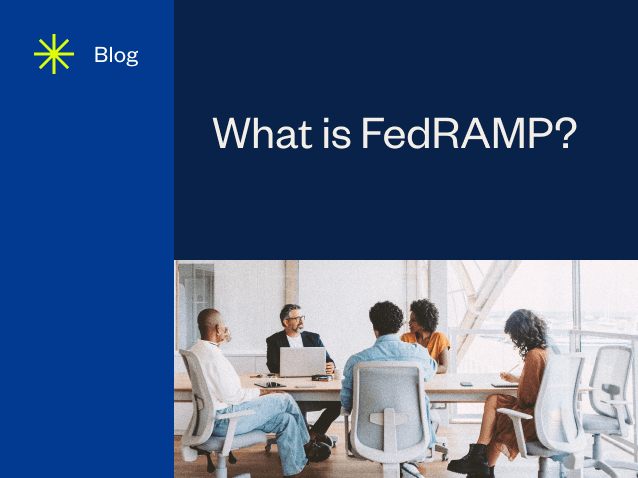What is FedRAMP? Complete Guide to FedRAMP Authorization

The U.S. government’s use of cloud technology brings new opportunities and risks. To protect sensitive federal data, robust security measures are not just recommended — they are required. Any organization planning to do business with a federal agency must understand these requirements.
One of the most important federal standards is the Federal Risk and Authorization Management Program, or FedRAMP. This page provides a comprehensive overview of the FedRAMP authorization process, its benefits, and recent updates every organization should know.
What is FedRAMP and why is it important?
FedRAMP, launched in 2011, is a government-wide program designed to standardize cloud security assessment, authorization, and continuous monitoring for cloud products and services used by federal agencies. Its primary goal is to accelerate secure cloud adoption across government bodies by implementing a unified and rigorous set of security controls.
By establishing a consistent baseline for evaluating and authorizing cloud services within the federal government, FedRAMP helps agencies trust the security of cloud offerings through ongoing monitoring and proven best practices. Achieving FedRAMP authorization demonstrates a cloud provider’s commitment to comprehensive federal security standards and is a critical step for providers aiming to do business with federal agencies.
Who needs FedRAMP authorization?
If you are a Cloud Service Provider (CSP) selling cloud offerings to U.S. federal agencies, you must obtain FedRAMP authorization. Federal policy mandates that only cloud systems with FedRAMP authorization can be used by agencies for data storage or processing.
Does FedRAMP apply globally?
Yes. International companies providing cloud solutions to U.S. federal customers must meet FedRAMP requirements.
Key benefits of FedRAMP authorization
Federal organizations are required to only use CSOs that are FedRAMP authorized when purchasing cloud services. Because of this mandatory compliance requirement, the main benefit of FedRAMP is enabling your organization to do business with federal agencies. However, there are other benefits to FedRAMP:
- Allows a single Authority to Operate (ATO) to be used across all federal agencies
- There is only one assessment, saving time and money
- Streamlines the assessment process, saving time and money
- Designed specifically to meet the needs of CSPs
How to get FedRAMP authorized
Achieving FedRAMP authorization is accomplished through Agency Sponsorship, where a federal agency works directly with a CSP to sponsor their FedRAMP authorization process. CSPs collaborate with the sponsoring agency throughout the authorization process to achieve an ATO.
The Agency Authorization process involves:
- An optional, yet highly recommended, FedRAMP Ready assessment
- Pre-authorization activities, such as preparing the System Security Plan (SSP)
- Achieving agency authorization, where the agency issues an ATO
- Continuous monitoring post-authorization to maintain compliance
What is FedRAMP 20x?
FedRAMP 20x is an initiative designed to accelerate the path to FedRAMP Low and Moderate authorization through simplifying processes and leveraging automation. A significant benefit of this program is that it allows a CSP to pursue authorization without needing an agency sponsor, addressing long-standing challenges around approval times and processes. This program, announced in March 2025, introduces key improvements, including:
- Automation of compliance: Using machine-readable processes to reduce manual tasks
- Continuous monitoring: Validating security through real-time data instead of periodic audits
- Direct collaboration: Encouraging more agile relationships between CSPs and federal agencies
- Rapid innovation: Eliminating delays to enable faster adoption of secure cloud services
FedRAMP assessment and authorization process
The assessment process follows a standardized set of steps:
- Preparation phase: The provider completes a comprehensive SSP for the cloud service. Afterwards, a FedRAMP-approved 3PAO develops a Security Assessment Plan.
- Full security assessment: The assessment organization submits a Security Assessment Report (SAR), and the provider creates a Plan of Action & Milestones (POAM). The security assessment involves evaluating the company’s policies and procedures against NIST 800-53 controls to test and validate security authorizations. Once security authorization is granted, continuous assessment and authorization guidelines must be in place to uphold that authorization.
- Authorization: The authorizing agency determines whether the risk as described is acceptable. If confirmed, they submit an ATO letter to the FedRAMP project management office. The provider is then listed in the FedRAMP Marketplace.
- Continuous monitoring: The provider sends monthly security monitoring deliverables to each organization using the service.
What’s the timeline of a FedRAMP assessment?
Before beginning the formal assessment, it’s crucial to conduct a gap analysis to identify and address any vulnerabilities in your system. This preparation ensures your organization is ready to navigate the FedRAMP process efficiently and achieve compliance.
Step 1: Pre-assessment review (1-4 Weeks)
Step 2: Planning activities (4 Weeks)
Step 3: Assessment activities (7 weeks)
Step 4: Reporting activities (5 weeks)
Step 5: Sponsor issues ATO (2-3 weeks) and listed in the FedRAMP Marketplace
Step 6: Maintain authorization (Ongoing)
How long is FedRAMP valid?
A FedRAMP Ready designation is only valid on the Marketplace for twelve months.
What are the impact levels of FedRAMP compliance?
FedRAMP categorizes cloud systems into impact levels to ensure appropriate security measures are applied based on the sensitivity of the data and the potential risks of a breach. These levels guide organizations in implementing the necessary controls to protect federal information.
- Low impact SaaS (LI-SaaS): LI-SaaS is a subset of the low impact level and typically includes over 50 controls that require independent assessment. This baseline is designed for SaaS applications that do not store personally identifiable information (PII) beyond basic login credentials, such as usernames and passwords. Organizations achieving LI-SaaS authorization would experience minor adverse effects in the event of a loss of confidential information.
- Low impact level: This level includes approximately 156 controls. Organizations achieving low authorization status would experience limited adverse effects if a loss of confidential information occurred.
- Moderate impact level: Moderate impact includes around 323 controls and applies to the majority of organizations. A loss of confidential information at this level would have a serious impact on the organization.
- High impact level: High impact includes approximately 410 controls and is primarily for organizations working in law enforcement, emergency services, financial systems, and health systems. A loss of confidential information at this level could have catastrophic consequences.
FedRAMP vs. other federal frameworks
FedRAMP is a crucial standard for cloud services, but it’s part of a larger ecosystem of federal compliance frameworks. Understanding how it differs from other key standards can help you determine the right path for your organization.
FedRAMP vs. FISMA
The Federal Information Security Modernization Act (FISMA) requires federal agencies to develop, document, and implement an agency-wide security program. The Risk Management Framework (RMF) is the process used to implement FISMA requirements.
While both FedRAMP and FISMA/RMF are based on NIST guidelines, they have a key difference in their authorization process.
- FedRAMP: Designed for CSPs, FedRAMP follows an “assess once, use many” model. A single FedRAMP authorization can be leveraged by any federal agency, making it a more efficient path for CSPs serving multiple government clients.
- FISMA/RMF: This authorization is specific to a single agency. If a provider needs an ATO for more than one agency, a separate FISMA/RMF assessment may be required for each one. This one-to-one design means authorizations are completed on an agency-by-agency basis.
FedRAMP vs. GovRAMP
Previously known as StateRAMP, GovRAMP was rebranded to reflect its expanded mission to support state, local, and educational (SLED) government entities.
- FedRAMP: Focuses exclusively on federal government agencies.
- GovRAMP: Provides a standardized security framework for cloud vendors working with state and local governments, as well as higher education institutions. It uses NIST 800-53 as its foundation, similar to FedRAMP, but is tailored to the needs of non-federal government bodies.
FedRAMP vs. CMMC
The Cybersecurity Maturity Model Certification (CMMC) is a framework required for organizations within the Department of Defense (DoD) supply chain. Its primary focus is on protecting Controlled Unclassified Information (CUI).
- FedRAMP: Applies to cloud products and services sold to any federal agency.
- CMMC: Mandatory for all organizations doing business with the DoD. The requirements vary based on the sensitivity of the information the contractor handles.
How to prepare for FedRAMP authorization
Starting the FedRAMP journey requires careful planning and preparation. Following a structured approach can help you navigate the process efficiently and avoid common pitfalls.
- Research your target agency: Identify which federal agencies align with your services and understand their specific needs and priorities.
- Conduct a gap analysis: Before diving into the formal assessment, perform a readiness assessment. This helps identify any gaps between your current security posture and FedRAMP requirements, allowing you to remediate issues early.
- Develop a System Security Plan: The SSP is the security blueprint for your system. This comprehensive document details your security controls and how they meet NIST 800-53 requirements. It should be fully developed and reviewed before the formal assessment begins.
- Engage a 3PAO: A FedRAMP-accredited 3PAO will conduct your security assessment and provide an independent report on your compliance.
Why Choose A-LIGN for your FedRAMP journey?
Navigating the complexities of FedRAMP requires deep expertise and a proven track record. A-LIGN is one of the few globally recognized cybersecurity providers that offers a single-provider approach for a wide variety of security frameworks, including FedRAMP, FISMA, CMMC, and more.
As a top 3 FedRAMP assessor with over 1,000 completed federal assessments, our dedicated team provides tailored solutions that meet your specific compliance objectives. Contact us today to get started.
